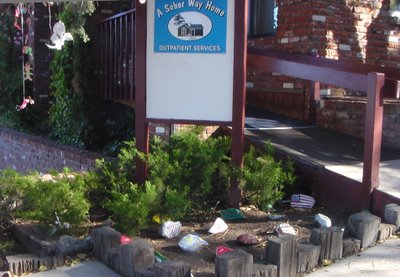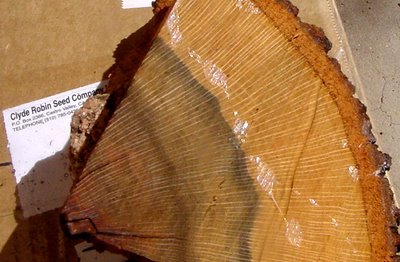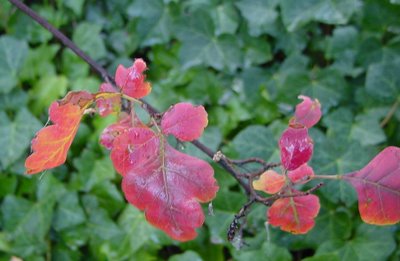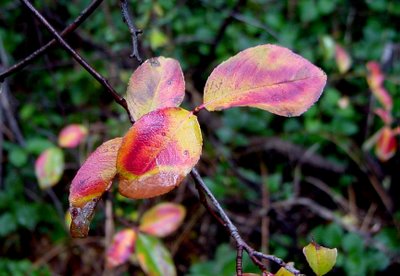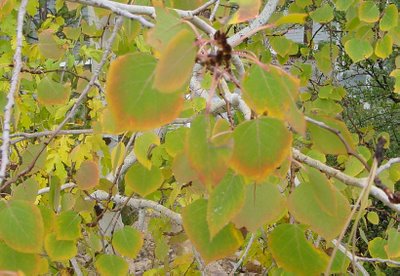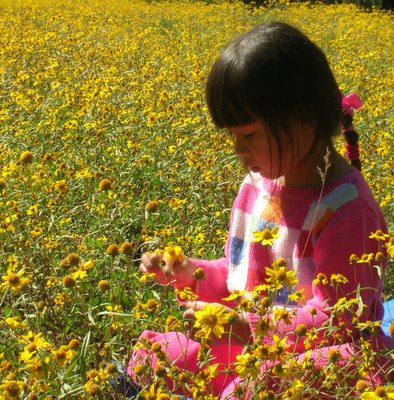
My Flagstaff daughter has established a charming fall tradition -- each year, she and the granddaughter pile into the little green car and head out to a high country meadow for a picture in the middle of golden flowers.
Autumn is indeed the time of year when nature seems dedicated to DYCs -- those Damned Yellow Composites, as botanists call them because 1) there are so many different kinds and 2) telling them apart is a major chore. My collection in this post is a mere sampling of the DYCs to be found around Prescott; I
think I've IDed them, except for one or two.

For example, I'm pretty sure that this single flower (and the field of daisies above) is goldeneye, one of several viguieras that color our hills in late September and early October.

On the other hand, this small ground-hugging yellow daisy will opportunistically cover the ground anywhere, everywhere come the Monsoon rains. It's very common -- I couldn't find it in any of my guides, even though the common camphorweed (below) is in all.
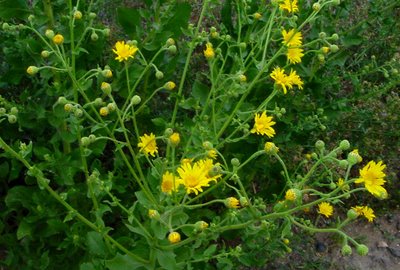
Which brings up the subject of that famous plant ID course taken by
everybody local that we met when we first moved to town in the mid 80s. According to friend Linda, Archie Dickey taught the course only in the winter-spring session at Yavapai College because of DYCs. He was famous for the course requirement: to positively and correctly identify 100 (later a mere 50) different local plants. Linda, who aced the course, explained that he didn't want to have the hassle of separating one DYC from another.

This is plains coreopsis -- a pretty thing that is often packaged in wild flower mixes. I don't believe that it is a local flower though it's quite happy here.

On the other hand, crownbeard loves my hill where it grows wildly and up to five or so feet tall. Note the leaves which are a dead giveaway to its sunflower heritage.

In contrast, goldenrod doesn't look like it's a member of the same family -- but it is.

Gumweed is usually found where weeds abound, so I guess that's how most people classify it. The center of the unopened flower (left) harbors a gummy substance, hence the name.
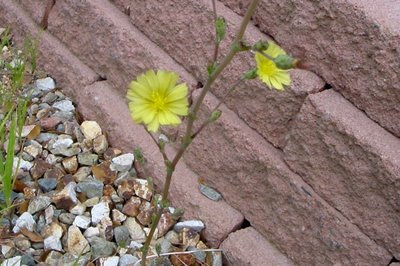
Couldn't find hide nor hair of this little fellow in any of the books. The flower is just 3/4" across and the foliage is of a
weedy character, i.e., it isn't anywhere near
garden quality -- instead, sort of scruffy. Like many composites, it makes a beautiful, airy little ball of parachute seeds.
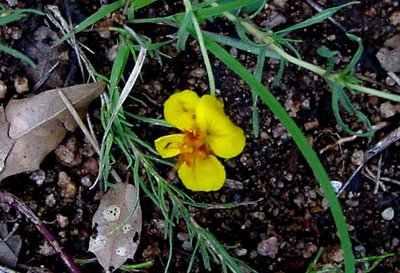
Believe it or not, this is a
zinnia -- I bought the plant years ago up at
Flagstaff Native Plants and it has spread, rewarding me with my first (and only) blossom this summer. I have seen pairie zinnia only on a small butte at the right-hand turn-off on SR89A just before it enters the canyon between Woodchute and Mingus mountains.
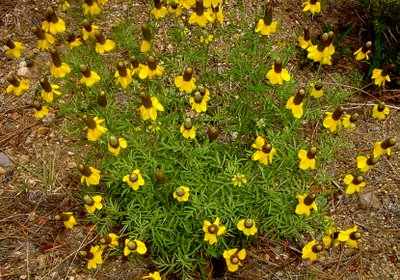
Mexican hat is another
asteraceae happy in these parts. This plant is one of many seeded by ADOT along the White Spar near the Ponderosa Park turn-off. I prefer the version that has mahogany colored petals (seeds for which are sitting in my kitchen awaiting rain.)

Desert marigold will bloom in spring, summer -- whenever -- with sufficient moisture. And before you tell me that Prescott is at too high an elevation to grow these neat little plants, let me refer you to the West Spruce Trail, where I've found a handful of plants thriving at 5200' elevation. On the other hand, I've had absolutely no luck growing them from seed. ADOT did seed marigolds along SR 69 between the I17 junction and Humbolt. Look for them next spring.

I couldn't figure out this small green-centered composite. My
Plants of Arizona showed a similar blossom called greeneyes, but the leaves were quite different. Info, anyone?

And here's one of my favorites -- ragleaf or bahia. Seems to like shadier spots, unlike so many of the sun-loving DYCs.
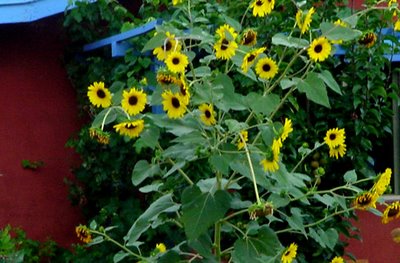
Sunflowers growing in Prescott gardens this summer were, of course, much more lush than those found by the roadsides. In fact, it seemed to me that the number of gardeners who have taken up sunflowers is definitely on the upswing. Now it's lesson time! According to
Backyard Nature:
The Composite Family is likely to be the best represented plant family in your backyard. Here are some of the best-known composites: Chicory, dandelion, chrysanthemum, yarrow, coreopsis, sunflower, Spanish needle, dahlia, zinnia, goldenrod, fleabane, aster, marigold, sneezeweed, groundsel, eupatorium, ageratum, lettuce, thistle, ironweed, cosmos, and Black-eyed Susan. L.H. Bailey's Manual of Cultivated Plants
, revised edition, lists 101 genera, or kinds, of composite found under cultivation.The amazing thing that composites have done is to miniaturize and simplify each flower, then pack a number of these tiny flowers on their ends next to one another, on a platform called a receptacle, and finally to organize the whole resulting cluster so that the many flowers look like just one flower. In other words the sunflower [above], is actually a collection of hundreds of flowers!Moreover, in that sunflower you are seeing two kinds of flower. The two composite-flower types are usually known as disk flowers and ray flowers ... the "flower's" broad central area is composed of hundreds of disk flowers, and the yellow "petals" are the ray flowers.
 No, I'm just taking you on a quick tour in my end of town to help get you revved up for All Hallow's Eve. A good starting point: the costume shop over on Miller Valley. This is one time that catching the reflections in the show window added to rather than subtracted from the effect!
No, I'm just taking you on a quick tour in my end of town to help get you revved up for All Hallow's Eve. A good starting point: the costume shop over on Miller Valley. This is one time that catching the reflections in the show window added to rather than subtracted from the effect!
 This elegant Victorian manages to look elegant decorated in matching spider webs and ghosts.
This elegant Victorian manages to look elegant decorated in matching spider webs and ghosts. Most of the decorations I saw yesterday were rather modest, such as a pumpkin and a witch. According to a report from the Natl. Retailers Association, Americans spend several $ billion on Halloween decor and it's the biggest single event of the year for the candy makers. No surprise, that.
Most of the decorations I saw yesterday were rather modest, such as a pumpkin and a witch. According to a report from the Natl. Retailers Association, Americans spend several $ billion on Halloween decor and it's the biggest single event of the year for the candy makers. No surprise, that. More other-worldly creatures...
More other-worldly creatures...
 And a big boost for the makers of white plastic garbage bags, which I saw transformed into ghosts in a number of neighborhood trees.
And a big boost for the makers of white plastic garbage bags, which I saw transformed into ghosts in a number of neighborhood trees.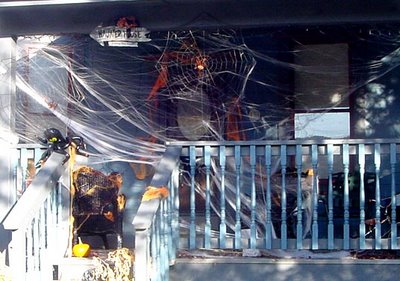 What kind of a dispenser is used for all those spider webs?
What kind of a dispenser is used for all those spider webs?
 My favorite holiday house, which is decorated -- and lit up -- for almost every holiday imaginable. Even St. Pat's and St. Valentine's.
My favorite holiday house, which is decorated -- and lit up -- for almost every holiday imaginable. Even St. Pat's and St. Valentine's.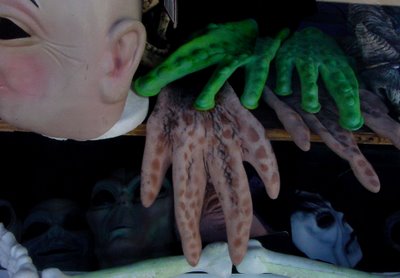 End of brief tour -- I have to get back to finishing Mom's costume for the party this evening!
End of brief tour -- I have to get back to finishing Mom's costume for the party this evening!

















